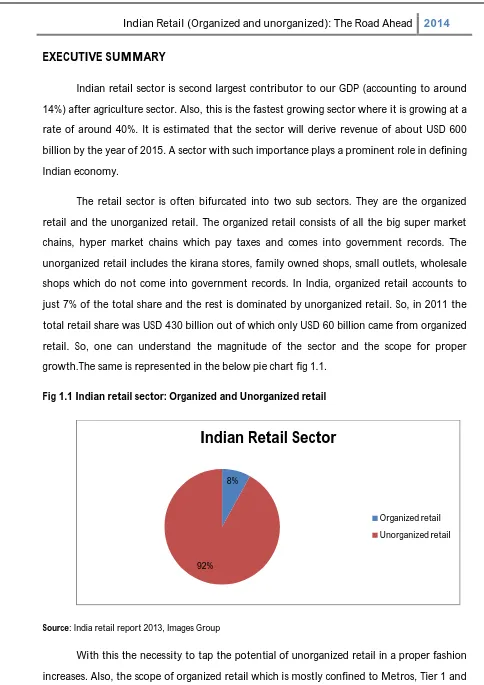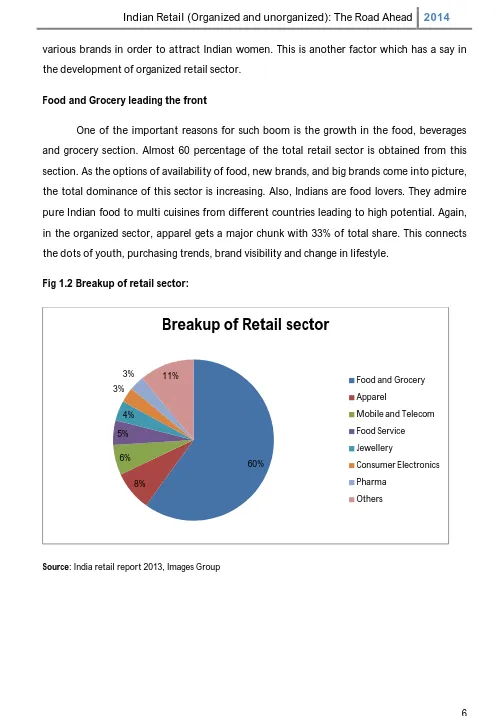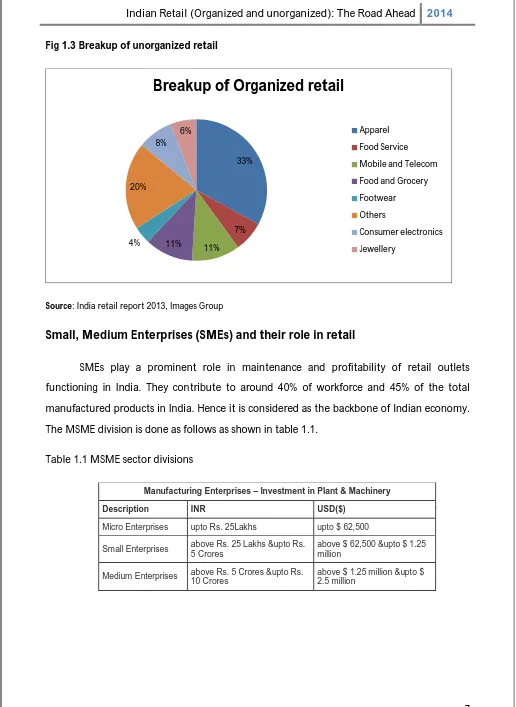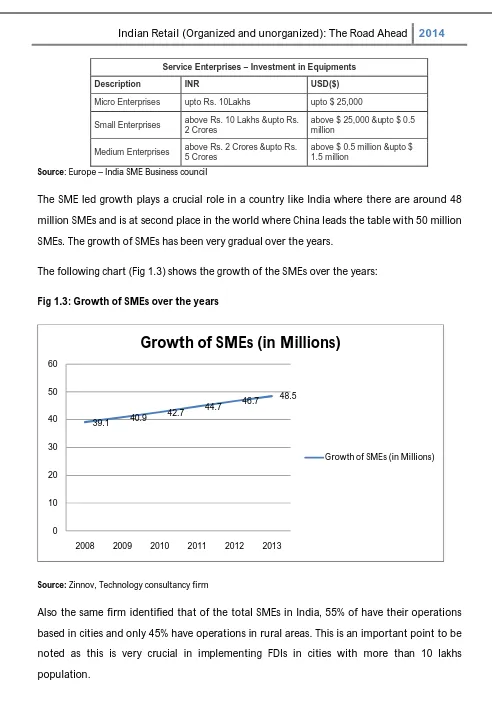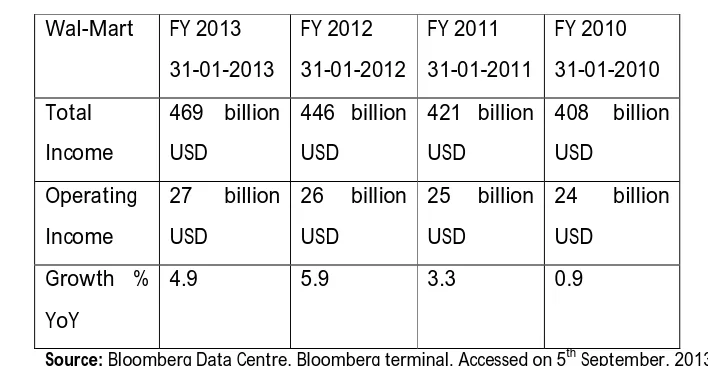1
Indian retail sector (Organized and Unorganized): The Road Ahead
Gullapalli Hari Kishan
Institute of Management Technology (IMT), Ghaziabad
Ghaziabad, NCR, India
PGDM - FT (Marketing)
Email ID:ft13gullapalliharikishan@imt.ac.in
Alternate Email:ghk235@gmail.com
2
ABSTRACT
The retail sector in India is one of the fastest growing sectors in the days ahead.
According to a study, it is estimated that there will be around 600 billion USD business by the
end of 2015. The consumer sitting at the end of the chain directs the market. So, whatever
decisions are implemented should be in the best of the consumer.
In the wake of 51% FDI allowance in multi brand retail, it is going to have high
impact on our retail industry, for sure. Even its impact is estimated to be limited to some
cities, the large network with which giants like Wal-Mart function, it is going to have a deep
impact in retail segment in terms of economy and reach. Taking companies like Wal-Mart
into consideration, they create a whole new retail ecosystem for them and will grow by leaps
and bounds. Already dogged with many problems like lack of proper infrastructure, lack of IT
penetration, improper and uneven supply chain, and small scale of operation, however large
may be the base, unorganized retail is facing new challenge in the form of FDI.
This work carries recommendations for unorganized retail in particular after
analysing all aspects related to all stakeholders and also after studying the success model of
organized retail in India.
KEYWORDS
3
EXECUTIVE SUMMARY
Indian retail sector is second largest contributor to our GDP (accounting to around 14%) after agriculture sector. Also, this is the fastest growing sector where it is growing at a rate of around 40%. It is estimated that the sector will derive revenue of about USD 600 billion by the year of 2015. A sector with such importance plays a prominent role in defining Indian economy.
The retail sector is often bifurcated into two sub sectors. They are the organized retail and the unorganized retail. The organized retail consists of all the big super market chains, hyper market chains which pay taxes and comes into government records. The unorganized retail includes the kirana stores, family owned shops, small outlets, wholesale shops which do not come into government records. In India, organized retail accounts to just 7% of the total share and the rest is dominated by unorganized retail. So, in 2011 the total retail share was USD 430 billion out of which only USD 60 billion came from organized retail. So, one can understand the magnitude of the sector and the scope for proper growth.The same is represented in the below pie chart fig 1.1.
Fig 1.1 Indian retail sector: Organized and Unorganized retail
Source: India retail report 2013, Images Group
With this the necessity to tap the potential of unorganized retail in a proper fashion increases. Also, the scope of organized retail which is mostly confined to Metros, Tier 1 and
8%
92%
Indian Retail Sector
Organized retail
4 some of the tier 2 cities should be spread out evenly pan India. These are some of the challenges faced by Indian retail and should be overcome using various steps like FDI, making unorganized retail more organized and some important policy changes.
Foreign direct investment (FDI) is one of the biggest measures to implant some stimulus in the retail sector. Currently, around 40 million Indians are employed in retail sector as a whole. This is a huge number and there is scope for much many jobs. With the reforms announced by the government of India, FDI of 100% is invited in single brand retail and FDI of 51% is allowed in multi brand retail, there is a great scope for job creation in retail sector. Also, with the deep pockets entering into the sector, we can see some phenomenal advancement in infrastructure and facilities employed.
On the flip side, there are some serious concerns raised by various business and trade circles about the dangers associated with having foreign investments. Some of them being closure of small kirana and other unorganized shops, Monopoly created by the big players and so on. There is validity in their case and any hasty step will result in irreversible loss with respect to our farmers, small retailers, small medium manufacturers and other suppliers.
Finally, in this paper the growth of organized retail, all aspects about unorganized retail, FDI and its impact, SMSE, and suggestive measures are discussed at length.
LITERARY REVIEW AND RESEARCH METHODOLOGY
Often we see papers discussing, academicians debating at length whether FDI is a boon or bane. When such situations arise, it is very common that the table is divided into two halves and debate starts. But there is limited work done on the way to tackle and check impact of FDI and steps to ensure that majority of the stakeholders are not impacted.
5 The methodology employed is, first the proven model of organized retail is discussed, then understanding the unorganized retail in India, the importance of SMSE, impacts of FDI, its framework and finally the ways to minimise the impact.
ORGANIZED SECTOR – A SUCCESS STORY
Indian retail is one of the prominent sectors which is always in boom. Also the future for this sector is quite promising. If we observe closely, the unorganized retail is in the same levels but the actual growth can be seen in the organized retail sector. It is estimated that the modern retail will be pegged at USD 175-200 billion by the year 2016. There are a plethora of reasons for this dynamic growth in organized retail.
Shift in shopping experience
The total shopping experience has been changed in India of lately, thanks to Pantaloons which laid foundation for shopping mall culture in India. Now a days, shopping is not just a daily or occasional activity, it has become a pleasure oriented activity and majorly a stress buster. With the earning abilities rising, people want a complete shopping experience which includes dining, recreational activities, events etc. at the shopping arena.
Youngsters dominating the demographics
A large chunk of today’s population is youngsters with the mean age near 25. They know their buying trends, what’s best for them and are brand specific. This has led to the thriving malls where many brands of large product range are put together. In fact, one can safely say that most of the brands are producing their products specific to this section of demographics.
Rise in working women population
6 various brands in order to attract Indian women. This is another factor which has a say in the development of organized retail sector.
Food and Grocery leading the front
One of the important reasons for such boom is the growth in the food, beverages and grocery section. Almost 60 percentage of the total retail sector is obtained from this section. As the options of availability of food, new brands, and big brands come into picture, the total dominance of this sector is increasing. Also, Indians are food lovers. They admire pure Indian food to multi cuisines from different countries leading to high potential. Again, in the organized sector, apparel gets a major chunk with 33% of total share. This connects the dots of youth, purchasing trends, brand visibility and change in lifestyle.
Fig 1.2 Breakup of retail sector:
Source: India retail report 2013, Images Group
60%
8% 6% 5%
4% 3%
3% 11%
Breakup of Retail sector
Food and Grocery
Apparel
Mobile and Telecom
Food Service
Jewellery
Consumer Electronics
Pharma
7
Fig 1.3 Breakup of unorganized retail
Source: India retail report 2013, Images Group
Small, Medium Enterprises (SMEs) and their role in retail
SMEs play a prominent role in maintenance and profitability of retail outlets functioning in India. They contribute to around 40% of workforce and 45% of the total manufactured products in India. Hence it is considered as the backbone of Indian economy. The MSME division is done as follows as shown in table 1.1.
Table 1.1 MSME sector divisions
Manufacturing Enterprises – Investment in Plant & Machinery
Description INR USD($)
Micro Enterprises upto Rs. 25Lakhs upto $ 62,500
Small Enterprises above Rs. 25 Lakhs &upto Rs. 5 Crores
above $ 62,500 &upto $ 1.25 million
Medium Enterprises above Rs. 5 Crores &upto Rs. 10 Crores
above $ 1.25 million &upto $ 2.5 million
33%
7%
11% 11%
4% 20%
8% 6%
Breakup of Organized retail
Apparel
Food Service
Mobile and Telecom
Food and Grocery
Footwear
Others
Consumer electronics
8
Service Enterprises – Investment in Equipments
Description INR USD($)
Micro Enterprises upto Rs. 10Lakhs upto $ 25,000
Small Enterprises above Rs. 10 Lakhs &upto Rs. 2 Crores
above $ 25,000 &upto $ 0.5 million
Medium Enterprises above Rs. 2 Crores &upto Rs. 5 Crores
above $ 0.5 million &upto $ 1.5 million
Source: Europe – India SME Business council
The SME led growth plays a crucial role in a country like India where there are around 48 million SMEs and is at second place in the world where China leads the table with 50 million SMEs. The growth of SMEs has been very gradual over the years.
The following chart (Fig 1.3) shows the growth of the SMEs over the years:
Fig 1.3: Growth of SMEs over the years
Source: Zinnov, Technology consultancy firm
Also the same firm identified that of the total SMEs in India, 55% of have their operations based in cities and only 45% have operations in rural areas. This is an important point to be noted as this is very crucial in implementing FDIs in cities with more than 10 lakhs population.
39.1 40.9
42.7 44.7
46.7 48.5
0 10 20 30 40 50 60
2008 2009 2010 2011 2012 2013
Growth of SMEs (in Millions)
9 The steady yet slow growth of SMEs owes to various reasons, the prominent ones being the following:
1. Low IT penetration
The IT penetration and the technology in running the firms is very obsolete leading to lower productivity. Although 40% of workforce is deployed in this sector, it accounts to only 17% of our GDP. The primary reason is that the firms choosing to be in unorganized sector without any technological updates.
2. Low scale – Low incentives
Although the workforce is huge, their scale of operations is very limited. Also, around 94% of the total SMEs operate with employees less than 10. This coupled with lack of technology will drop the scale to lowest numbers and in turn the incentives will be less leading to fewer investments in technology. This acts like a cycle dogged by lack of innovation.
3. Highly unorganized sector
Most of the firms operating in this sector try to avoid taxes and operate in unorganized zone leading to no help from government. This leads to fragmentation and in the wake of FDI will cause a serious threat to their very existence.
Hence, whatever the facts maybe, it cannot be denied that SMEs play a crucial role in our retail and manufacturing chain which should be properly taken care of. The steps to improve the present condition will be dealt at a later stage.
The Unorganized retail – Sleeping Potential
10 There are some serious concerns associated with this form of retail. The prominent ones being:
1. Less risk taking ability and hence less innovation in their store space and sell standardized products.
2. Lack of proper inventory management and supply chain management. With no proper consumer behaviour data and buying trends, these retailers face the issue of proper inventory levels thereby leading to outdated stock or lack of products. Also, the storage quality gets affected.
3. Irregular pricing mechanisms irrespective of the offers provided by malls. 4. Lack of proper spacing
5. Actually, these are stores which have something to sell. So, these stores lack proper infrastructure and facilities.
6. With many farmers leaving agriculture as their primary livelihood, these people tend towards small kirana shops which don’t have any barriers to enter.
7. Individualistic. That is, one store is mostly not related to any other store in any manner and hence any major change in the market impacts them alike. The same we will discuss at a later point of time.
Success factors:
Although there are many concerns associated with the unorganized retail, there are some factors which accounted for their sustenance and success. They are:
1. Home delivery is their flagship idea. Small kirana stores or corner side departmental stores provide home delivery of our purchases which many people staying in colonies use. Such facilities are provided irrespective of the amount and quantity of purchases we do.
2. Credit is something which is not present even today in organized retail stores. Or we can say is present in the form of credit cards. But the flexibility and reliability of the credit facilities provided by the stores is immense. Middle class who cannot afford purchasing goods by paying cash daily utilize this to the maximum possible extent. 3. These stores are often near to a colony of houses or complexes where a lot of
11 and the buyers find the shopkeeper near. In this way, proximity of the both is assured.
FOREIGN DIRECT INVESTMENTS (FDI)
We all know that government has opened up 100% FDI in single brand retail and 51% FDI in multi brand retail. Now, let us delve deep into the framework of FDI and how companies like Wal-Mart, Tesco, and Carrefour function making this framework most viable to them.
When it comes to the companies like Wal-Mart, they create a whole together new ecosystem and establish as a leading store eliminating competition to the maximum possible extent. The Wal-Mart is a classic example of such expansion. It acquires the local players, establishes best in class supply chain thereby eliminating local manufacturers and finally tries to achieve monopoly in that city.
If we look at some of the financialsof Wal-Mart(table 1.2), we can clearly understand how deep their pockets are.
Table 1.2: Financials of Wal-Mart
Wal-Mart FY 2013 31-01-2013 FY 2012 31-01-2012 FY 2011 31-01-2011 FY 2010 31-01-2010 Total Income
469 billion USD
446 billion USD
421 billion USD
408 billion USD
Operating Income
27 billion USD
26 billion USD
25 billion USD
24 billion USD
Growth % YoY
4.9 5.9 3.3 0.9
Source: Bloomberg Data Centre, Bloomberg terminal, Accessed on 5th September, 2013
So, implementing FDI based on policy implications is an imperative for better ecosystem and co-existence of all the stake holders.
12 1. At least 50% of the total investment should be utilized for developing the back end
infrastructure.
Impact on other retailers:This step leads to the healthy competitive spirit in the
other retailers. As we have already seen, this shall utilize the money from the deep pockets of the retail giants and implement the same in the infrastructure building like improved supply chain, improved inventory management and IT infrastructure for a better management. So, the other retailers try to achieve the same and hence a healthy competition arises to manage the firm properly.
Impact on SMEs: This particular step will not have much impact on the SMEs as this
is related to internal infrastructure development.
Impact on unorganized retailers: These retailers will be adversely affected as these
do not have proper infrastructure or monetary support to achieve the same. So, on the inventory management and supply chain fronts these will lose. This will have adverse effects on revenue.
Impact on consumers:As the firm has got better infrastructure, the consumers will
have a nice appeal while purchasing the products. They will enjoy a nice experience purchasing in a well-managed store.
2. Large discount stores will be allowed to be set up only in cities with population more than 10 lakhs and in states which allow FDI in multi brand.
Impact on other retailers:All other retailers both of organized and unorganized are
severely hit in select cities. If we consider cities with more than 10 lakh population, there are around 53 cities in India which covers all the metros, Tier 1, Tier 2 and some of the Tier 3 cities. This penetration is pretty wide as most of the happening places and places which have considerable amount of purchasing power are covered. Impact on SMEs:There will be deep negative impact upon the SMEs present in the
urban areas. Previously we have seen that 55% of total SMEs are from urban areas. As the operations will not be limited to these cities, more concerns will be raised by SMEs in urban cities.
Impact on unorganized retailers: If the proposed multi brand stores are situated in
13 start moving from the corner side stores to big retail stores and purchase in bulk to store for future.
Impact on consumers:Consumers will get many offers, quality and cheap products.
Also, they will try to purchase in bulks and obtain some products which they might be trying out for the first time. So, for a consumer this will be the best move especially for people staying in metros and Tier 1, 2 and 3 cities.
3. The foreign retailers have to source at least 30% of their goods from smaller retailers.
Impact on other retailers and consumers: This doesn’t have much impact on the
retailers and the consumers.
Impact on SMEs: This shall prove to be a welcome move by SMEs. This means that
whatever apart from the raw materials, supplies imported from other countries, 30% of the total raw materials and supplies needs to be obtained from small and medium enterprises. This will boost the urban and some rural SMEs as well. But of lately, the retail giants are putting pressure to reduce this ratio to 20%. The main reason for their lobbying is they obtain margins on the cheap material they import from abroad. If they get such material, then only they can produce at a cheaper rate and sell with huge margins in bulk.
4. At least 1/3rd of the sales need to be done to small retailers.
Impact on unorganized retailers: This move is a welcome move for small
unorganized retailers and doesn’t have any impact on the rest of the stakeholders. These will improve the sales to retailers at cheap prices, where small retailers from nearby towns and cities will purchase from them and will sell at a small margin. In this way, government is trying to save small and unorganized retailers.
These are some of the policy guidelines suggested by government of India and shall be monitored by the respective state governments. So, granting, denying and implementation
lie in the hands of state governments only.
14
Steps to boost and rejuvenate unorganized sector, SMEs:
The following are some of the steps which are aimed at reducing the impact of FDI on unorganized retail and improve the sector as a whole.
1. All the SMEs should be brought under one umbrella where they should be given licenses and should be made organized. These identified SMEs shall be chose for selection of supplies for big retails. This will be implemented based on geographies and on rotation basis thereby eliminating unwanted competition and closure. Also during this period, all the SMEs are free to supply goods and material to all other local retailers as well.
2. The independent unorganized retailers who operate on their own should be brought under one space where multiple retailers of various products will be brought under one roof. This model is actually an implemented successful model and is often seen with the name of “Market”. Such models eliminate some of the unorganized retail and provide equal opportunity to all retailers. So, peer competition leads them to increase quality at par with other big retailers.
3. Government should strike deals with IT majors and other infrastructure giants to develop infrastructure of major unorganized and medium to large retail outlets. This improves their supply chain and inventory management along with enabling them with IT. Very recently, Microsoft came up with such implementation where it offered such solutions to SMEs and retailers.
4. Recently, there has been a debate to reduce the local procurement by global giants to 20% from 30% which is pretty low. If this gets implemented, there will be clear negative impact on the local SMEs. Hence the procurement quantity should be restricted to 30%
5. Also, there should be some regulations in allocation of land to global giants especially in the tier 2 and tier 3 cities thereby helping the local retailers to improve their margins even when competing with the global giants.
15
CONCLUSION
The implementation of FDI is a very good move if deployed judiciously. India is a country which is self-sustained till date in the case of unorganized retail. Hence, if we introduce harsh measures, they will be forced to shut down completely and ourselves getting exposed to the might and whims of global giants. So, we are supposed to keep the local players in incubation period and create a positive co-operative ecosystem which in long run will help the nation economically. Indian retail is the future. Big global giants cannot ignore Indian retail potential. It’s time we harness it to the maximum possible extent.
REFERENCES
1. Adecco TISS Labour Market Research Initiatives (ATLMRI), A comparison of unorganized and organized retail in India, by ShaoniShabnam andBino Paul G.D, December, 2008.
2. An Insight into the Growth of New Retail Formats in India by Piyush Kumar Sinha Sanjay Kumar Kar, W.P. No.2007-03-04 March 2007, IIM – Ahmedabad.
3. Effect of Orgenised retail on Unorgenised retail in Indian retail market, Research Journal of Management Vol. 1(1), 7-13, August (2012) by Gupta Himanshu, DubeyNeetu and PataniPawan.
4. FDI in Retail & its impact on MSMEs invitation, Feb 2012 by IIA 5. Global powers of retailing 2013, retail beyond.
6. http://www.eisbc.org/Definition_of_Indian_SMEs.aspx
7. http://www.thehindu.com/business/Industry/it-can-help-indian-smes-boost-revenue-by-56-billion-says-microsoft/article5217864.ece
8. http://articles.economictimes.indiatimes.com/2013-06-09/news/39834857_1_smes-workforce-small-and-medium-enterprises
9. http://en.wikipedia.org/wiki/Retailing_in_India
16 11.International Journal of Multidisciplinary Research Vol.2 Issue 1, January 2012, ISSN 2231 5780, www.zenithresearch.org.in 281, ORGANIZED RETAILING IN INDIA – CHALLENGES AND OPPORTUNITIES by DR.SHAHID AKHTER; IFTEKHAR EQUBAL. 12.Mukherjee, Subhadip. 2011. Policies of retail sector of India and other selected
countries. UTMS Journal of Economics 2 (2): 171–180.
